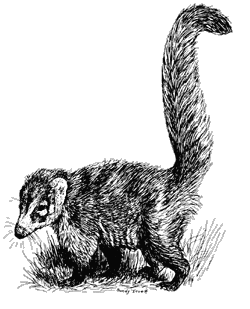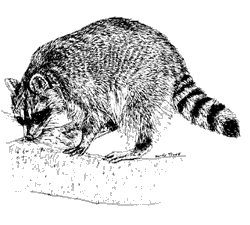Procyonids: Raccoons, Ringtails & Coatis
Among the most unusual, most handsomely marked, and least known of our desert animals are the procyonids — the raccoon, ringtail, and coatimundi. The raccoon is the most familiar of these, but mostly because people have seen it in other parts of the country. Many are surprised to learn that the raccoon does quite well in the Sonoran Desert, as long as there is water somewhere nearby. You can easily follow raccoons’ distinctive tracks along trails leading directly to suburban desert swimming pools.

The ringtail is Arizona’s state mammal, though few people have ever seen one in the wild. Large black eyes, big pink ears set on a tiny face, and a long black-and-white ringed tail that looks like a feather boa make this appealing little animal look almost cuddly, but it is really a very efficient predator. One can sometimes be seen at night as it prowls around its rocky canyon home, peering into niches and cracks where a mouse or an insect might be hiding.
Even though the coati is diurnal and lives in social bands of up to 30 or more animals, most people never see them, unless they make frequent visits to the oak-sycamore canyons and riparian areas coatis favor. Like the raccoon and the ringtail, coatis forage both on the ground and in trees, and are omnivores.
Sonoran Desert species:
raccoon (Procyon lotor)
ringtail (Bassariscus astutus)
coati, coatimundi (Nasua narica)
Order: Carnivora
Family: Procyonidae
Spanish names: mapache, batepi, lavador (raccoon), cacomixtle (ringtail),
chulo, coatí, solitario (coati)
Distinguishing Features

- Raccoon:
- A heavy-bodied animal of about 10 to 30 pounds (4.5-13.5 kg) with a black face mask edged in white and a bushy, ringed tail. The hind foot is plantigrade (that is, the sole is walked on, as with humans).
- Ringtail:
- A grayish-brown squirrel-sized animal (about 1 to 2 pounds) with a fluffy black and white ringed tail that is usually longer than its body. It has large black eyes ringed with white, big ears, and a narrow, pointy muzzle. Unlike raccoons and coatis, ringtails don’t walk on the soles of their feet, one reason they are sometimes placed in their own family (Bassariscidae).
- Coati:
- The coati is a curious-looking beast, longer than a racoon (though not as husky in the body), with a long nose and a facial mask. Its very long tail is not as distinctly ringed as are those of the raccoon and ringtail.
Habitat
Raccoons prefer riparian habitats, and brushy and wooded areas. The ringtail lives most often in riparian canyons, especially in areas with rocky outcrops, caves, and mine shafts, and usually not in heavily wooded areas. Coatis inhabit mountain canyons with oak and sycamore in the summer, sometimes moving to lower-elevation riparian canyons or passing through desert areas in the winter.
Feeding
- Diet:
- All three species are omnivores. The raccoon feeds on small mammals, carrion, fruit and nuts, insects, eggs, fish and aquatic insects. The ringtail favors a diet of rodents, fruit, birds, snakes, lizards, and insects. The coati eats a lot of grubs, beetles, and other invertebrates, and also fruits and nuts, rodents, eggs, snakes, lizards, and carrion.
- Behavior:
- Raccoons use their front paws to feel for food items in murky water or leaf litter. Ringtails inspect likely niches and hiding spots in their rocky habitats, hunting for rodents, birds, centipedes, and anything else edible. They are excellent mousers, pouncing and killing with a bite to the back of the rodent’s neck. Coatis dig in the soil and leaf litter using their long claws or their noses to turn up grubs, worms, or other invertebrates. They also turn over large rocks with their front paws to search for invertebrates, lizards, and snakes.
Life History
Raccoons are nocturnal and usually solitary, unless they congregate at man-made food sources such as picnic areas or campgrounds. They prefer brushy, thickly vegetated habitats, but adapt very well to the many artificial ponds, lakes, and wetlands found in the suburbs and housing developments. They can eat almost anything; their dexterous paws can easily open garbage cans, so they can readily take advantage of discarded food.
In the warm desert climate, a raccoon may sleep away the day out in the open, draped over a tree branch.

Ringtails are strictly nocturnal animals, using their large eyes and keen sense of smell to locate prey. They are excellent climbers and leapers, using their long tails for balance as they negotiate steep canyon walls or trees with equal ease. The ringtails have semi-retractable claws and can rotate their hind feet 180 degrees, allowing them to descend cliffs face first. They den in niches in rock walls, boulder piles, or hollow trees. Ringtails are solitary, only pairing up for a few days of mating in April. The 2 to 4 kits are born in June. By fall the young can hunt for themselves and soon disperse. Though fierce little fighters, ringtails fall prey to great horned owls, bobcats, and coyotes. When frightened, they emit a musky odor from anal scent glands.
Coatis are very social animals, living in bands of up to 20 or even 30 or more. The bands consist of females and their young. Adult males are not welcome, except during mating season, although lone males may follow a group at other times. A pregnant female leaves the group to deliver her 4 to 6 babies, rejoining the group several weeks later with her new offspring.
Coatis are diurnal, active mostly in the morning and late afternoon, then spending the night in trees or caves. As coatis forage through an area they travel with their 2 foot (.6 m) long tails held vertically.
Beach Bandits
We associate raccoons with woods, fields, and streams, but they also live in desert locations. On scuba-diving trips to the Sonoran shoreline along the Sea of Cortez, we’ve encountered raccoons living on and near a beach in the Central Gulf Coast subdivision, considered one of the driest portions of the Sonoran Desert. Only at infrequent intervals is fresh water available to these animals at this location. It appears they survive, at least in part, by the moisture derived from catching and consuming tide pool animals and by eating detritus cast up on the beach.
These raccoons are master scavengers. When humans set up camp on this beach, which is isolated and far from any permanent human habitation, the raccoons are quick to raid. At night they survey the camp from a nearby cliff, eyes shining in light reflected from lanterns or campfire. When the campers retire for the night, the raccoons enter camp and consume any groceries carelessly left about, drink water drops dripping from ice chest drains, and occasionally run across sleeping campers.
— Lane Larson, owner, Caiman Expeditions










